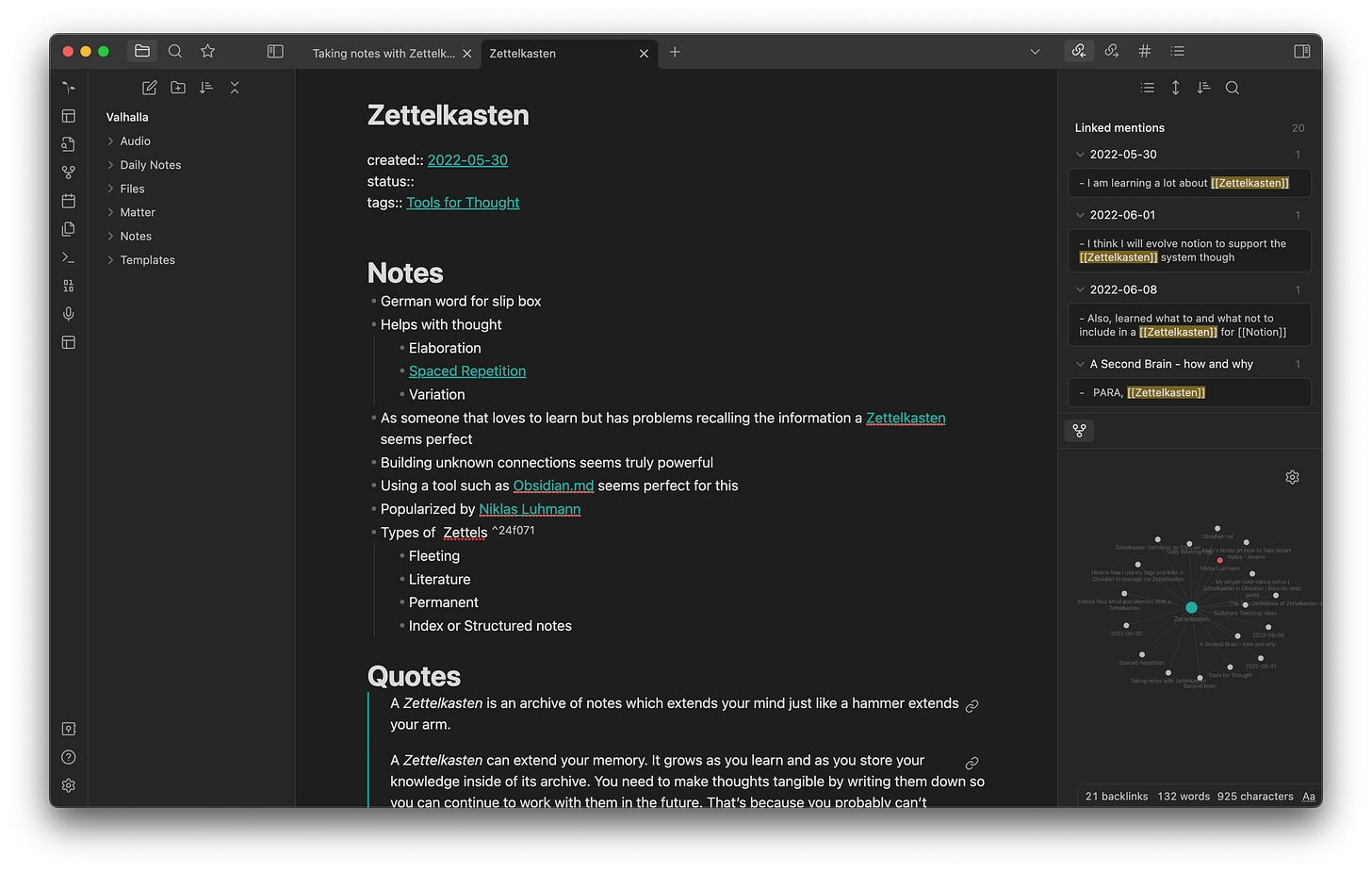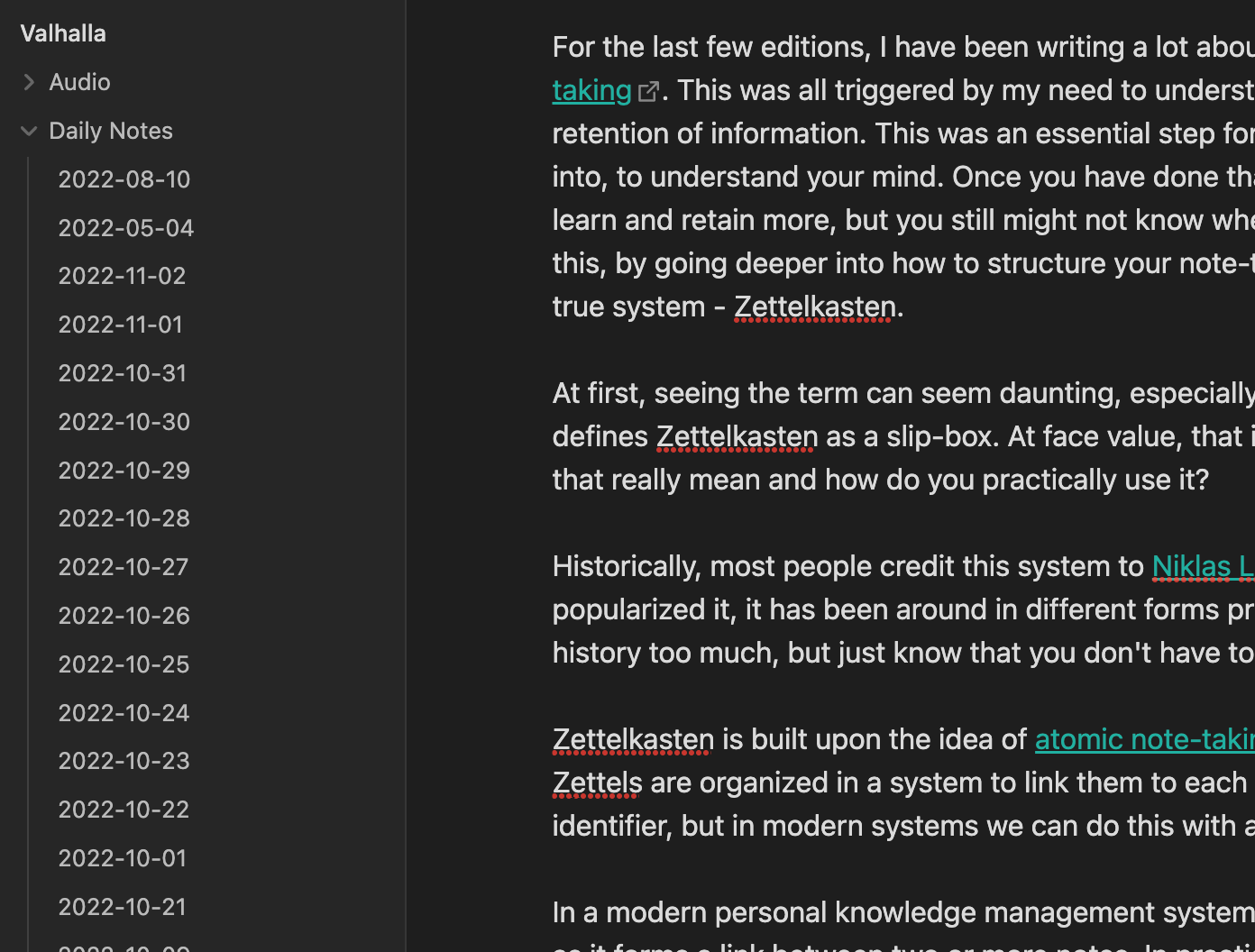For the last few editions, I have been writing a lot about augmenting our minds and note-taking. This was all triggered by my need to understand how I think and how to improve my retention of information. This was an essential step for me and one I recommend diving deep into, to understand your mind. Once you have done that, atomic note-taking can help you learn and retain more, but you still might not know where to start. Today's edition builds upon this, by going deeper into how to structure your note-taking and thinking through a tried and true system - Zettelkasten.
At first, seeing the term can seem daunting, especially for English speakers. A simple translation defines Zettelkasten as a slip-box. At face value, that is the system as a whole, but what does that really mean and how do you practically use it?
Historically, most people credit this system to Niklas Luhmann and while he is the one that popularized it, it has been around in different forms prior to him. I'm not going to get into the history too much, but just know that you don't have to follow his version of the system.
Zettelkasten is built upon the idea of atomic note-taking. Each note is a Zettel and these Zettels are organized in a system to link them to each other. Historically, they are related via an identifier, but in modern systems, we can do this with a bi-directional link.
In a modern personal knowledge management system (PKM), bi-directional links are essential, as it forms a link between two or more notes. In practice, this means that you don't have to define or provide context when linking two notes, as the deeper information lives in the other note. This allows for information to stay consistent and is always up to date. If your knowledge or opinions evolve on a subject, you can update that in one place and the links will inherit this. This concept feels commonplace in a society built upon the internet and hyperlinks but is still not very common when it comes to note-taking.
After you understand the concept of bi-directional linking, you should understand how to structure your notes. As it relates to Zettelkasten, it is common to create digital folders that house types of notes. These types are generally: fleeting, literature, permanent, and index notes. How do you use these practically?
Randomly jotting down notes, without any evolution or structure to reference them doesn't provide value.
Fleeting
Quick notes, that are captured in the moment. This can be a thought, an idea, or something interesting. This is generally the first stage of a note, as they tend to evolve into something else.
Literature
Notes about a learning topic, generally a book, article, or research paper. These can also be quotes from these sources.
Permanent
Notes that are written 100% by you and are thoughtfully crafted. These are generally longer form, more evolved notes, linking to literature and fleeting notes for reference.
Index
Also known as structured notes. These can be solely used to group like notes together or provide some story to multiple notes.
All of these notes can be organized into folders, databases, or tags – if your tool allows for it. Yes, this is a lot of structure. I like the concepts around this structure, but not the structure itself. I recommend understanding the why behind it and adjusting it to your needs.
So what is the why? Because randomly jotting down notes, without any evolution or structure to reference them doesn't provide value. I break my notes up into two core folders, but I do have a few complimentary folders that support them.
Daily Notes
One of the key parts of my system is the idea of a single daily note. A lot of tools support this out of the box too. This is where I jot down thoughts, ideas, learnings, some meeting notes, almost anything. I try not to provide too much structure here, as it limits its use case. This is my "fleeting note" area. They live in their own folder and are titled the current day’s date.
Notes
Is a catch-all, for almost everything else. This is where most literature notes live. Though I don't think of them as literature, I think of them as “content”. This is where my permanent notes live too. I don't separate these, as I don't want to worry about something living in a certain folder. I feel like notes evolve up or down as my thinking changes and I don't want to segment them any differently. A permanent note is a very noticeable one, as the note is fuller and has more of my actual thoughts on a topic.
Some Zettelkasten systems also have a place for sources. These are people or publications related to a piece of "content". I don’t segment these via a folder, I simply tag them using my nested tag system: crm/x/y/z.
As you can tell, I don’t prescribe to a specific system but I do derive a lot of my system from Zettelkasten. I find that the core principles work well with my thinking and creation style. The tool I have been using lately to support this system is Obsidian. You can use whatever tool works for you, so don’t feel compelled to use it. I have also built a comprehensive system in Notion that supports it well.
Regardless of the tool or system, the practice of note-taking is most important. Zettelkasten can provide structure, especially when you are not sure where to start. But don’t feel like you need to follow it to the T. I’d also recommend keeping it digital and modern, unless you want to lug around 90,000 notes in boxes, like Niklas Luhmann.
Subscribe to Async Chats! | Follow on Twitter | Newsletter Feedback Form




Thank you for sharing, Thor! I stumbled across your post while I was looking into the Zettelkasten method and integrating it with Obsidian. I like how concise you've been able to explain the system (the many Youtube videos I've seen can be somewhat confusing at times) and I have a couple of questions, if that's alright with you.
First, I understand the concept of fleeting notes as any ideas that may come up whenever and that we would write that down in 1-5 sentences. As I consume a lot of media from the internet, and find interesting bits there, would it be located at the Literature notes section once I 'parse' that initial main idea and put that into my Fleeting note section?
Second, this is just out of curiosity mostly haha but, how do you approach organizing your daily notes or any other notebooks that have a lot of notes within them? If you were to make a note each day and that eventually builds up, would it not be cluttered over on the side bar?